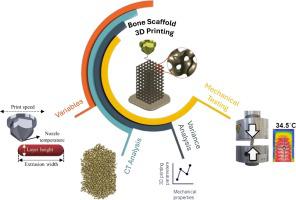当前位置:
X-MOL 学术
›
Int. J. Fatigue
›
论文详情
Our official English website, www.x-mol.net, welcomes your
feedback! (Note: you will need to create a separate account there.)
Impact of 3D printing parameters on static and fatigue properties of polylactic acid (PLA) bone scaffolds
International Journal of Fatigue ( IF 5.7 ) Pub Date : 2024-05-27 , DOI: 10.1016/j.ijfatigue.2024.108420 Hamed Bakhtiari , Alireza Nouri , Majid Tolouei-Rad
International Journal of Fatigue ( IF 5.7 ) Pub Date : 2024-05-27 , DOI: 10.1016/j.ijfatigue.2024.108420 Hamed Bakhtiari , Alireza Nouri , Majid Tolouei-Rad

|
In the present study, polylactic acid (PLA) scaffolds with a 60 % porosity and gyroid pore structure were 3D printed using the extrusion-based method and employing various printing parameters. The specimens were loaded under quasit-static and cyclic conditions and their mechanical behaviour were evaluated. The Taguchi method was utilized to design experiments and investigate the impact of printing parameters on the compressive properties of the scaffolds. Moreover, thermography analysis was used to examine the influence of cyclic heating during fatigue experiments. The results indicated that extrusion width was the sole variable significantly affecting the quasi-static properties of scaffolds. The largest extrusion width (0.65 mm) resulted in the highest compressive properties (6–7 MPa), plateau stress (8–9 MPa), and compressive modulus (200–215 MPa). However, fatigue experiments revealed that nozzle temperature was the sole influencing factor on the fatigue performance of scaffolds, with specimens printed at low nozzle temperature (190 °C) demonstrating the highest fatigue resistance. Thermography analysis exhibited a negative correlation between scaffold temperature and stiffness. However, the impact of temperature on the structural integrity of the scaffolds was insignificant, given that the highest temperature recorded during fatigue cycles (i.e., 39 °C) was below the glass transition temperature of the scaffolds’ material.
中文翻译:

3D打印参数对聚乳酸(PLA)骨支架静态和疲劳性能的影响
在本研究中,使用基于挤出的方法并采用各种打印参数 3D 打印了具有 60% 孔隙率和螺旋孔结构的聚乳酸 (PLA) 支架。样品在准静态和循环条件下加载,并评估其机械性能。利用田口方法设计实验并研究打印参数对支架压缩性能的影响。此外,热成像分析用于检查疲劳实验期间循环加热的影响。结果表明,挤压宽度是显着影响支架准静态性能的唯一变量。最大挤出宽度 (0.65 mm) 产生最高的压缩性能 (6–7 MPa)、平台应力 (8–9 MPa) 和压缩模量 (200–215 MPa)。然而,疲劳实验表明,喷嘴温度是支架疲劳性能的唯一影响因素,在低喷嘴温度(190°C)下打印的样本表现出最高的抗疲劳性。热成像分析显示支架温度和刚度之间呈负相关。然而,考虑到疲劳循环期间记录的最高温度(即 39°C)低于支架材料的玻璃化转变温度,温度对支架结构完整性的影响微不足道。
更新日期:2024-05-27
中文翻译:

3D打印参数对聚乳酸(PLA)骨支架静态和疲劳性能的影响
在本研究中,使用基于挤出的方法并采用各种打印参数 3D 打印了具有 60% 孔隙率和螺旋孔结构的聚乳酸 (PLA) 支架。样品在准静态和循环条件下加载,并评估其机械性能。利用田口方法设计实验并研究打印参数对支架压缩性能的影响。此外,热成像分析用于检查疲劳实验期间循环加热的影响。结果表明,挤压宽度是显着影响支架准静态性能的唯一变量。最大挤出宽度 (0.65 mm) 产生最高的压缩性能 (6–7 MPa)、平台应力 (8–9 MPa) 和压缩模量 (200–215 MPa)。然而,疲劳实验表明,喷嘴温度是支架疲劳性能的唯一影响因素,在低喷嘴温度(190°C)下打印的样本表现出最高的抗疲劳性。热成像分析显示支架温度和刚度之间呈负相关。然而,考虑到疲劳循环期间记录的最高温度(即 39°C)低于支架材料的玻璃化转变温度,温度对支架结构完整性的影响微不足道。











































 京公网安备 11010802027423号
京公网安备 11010802027423号